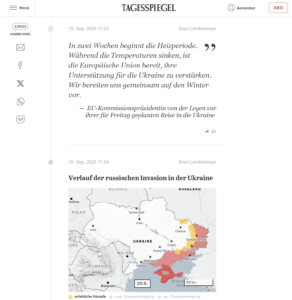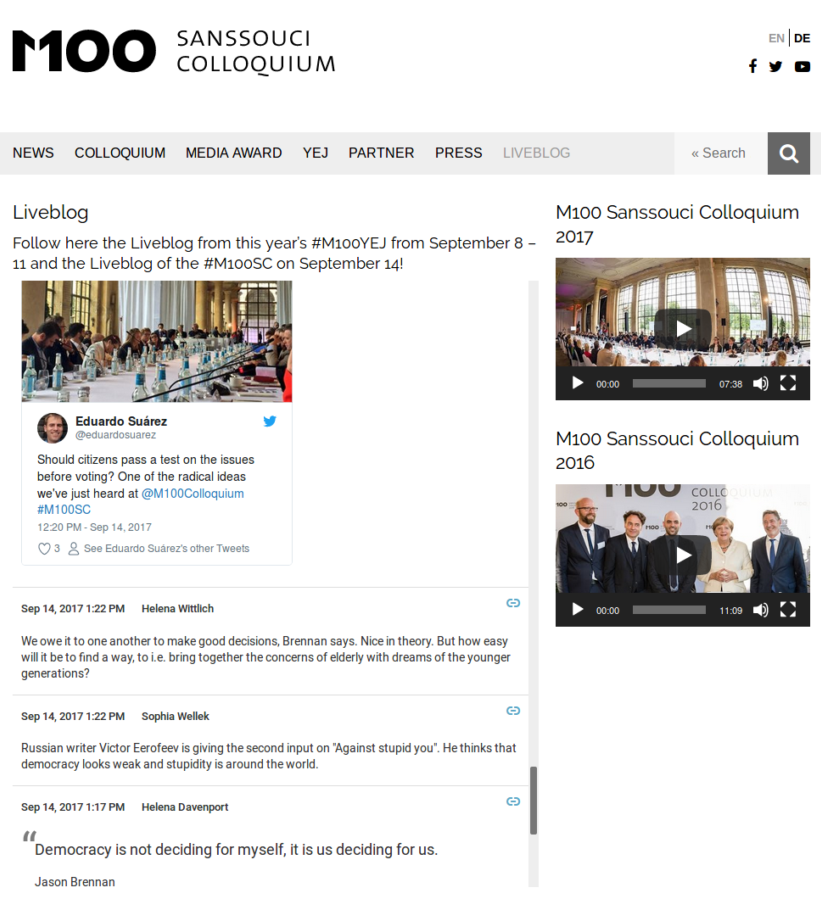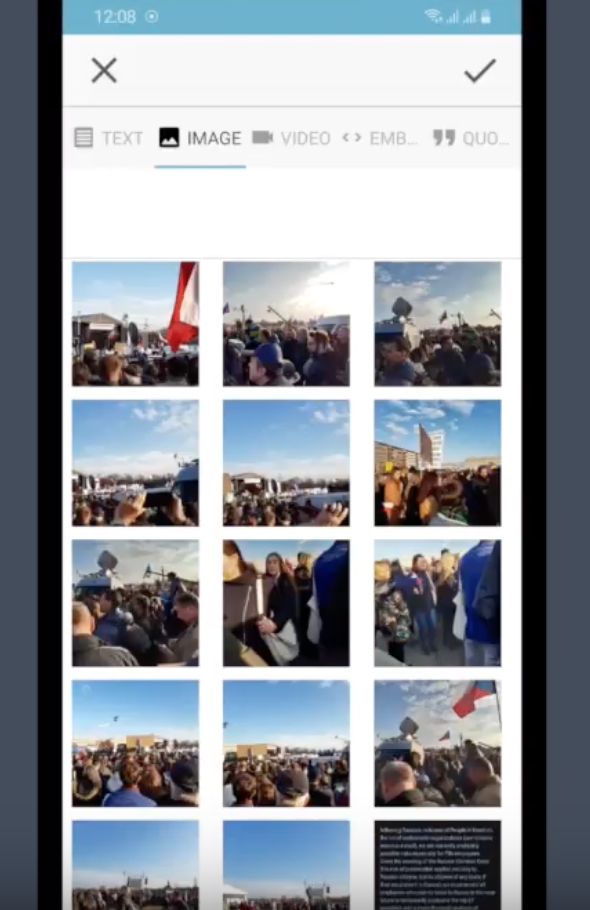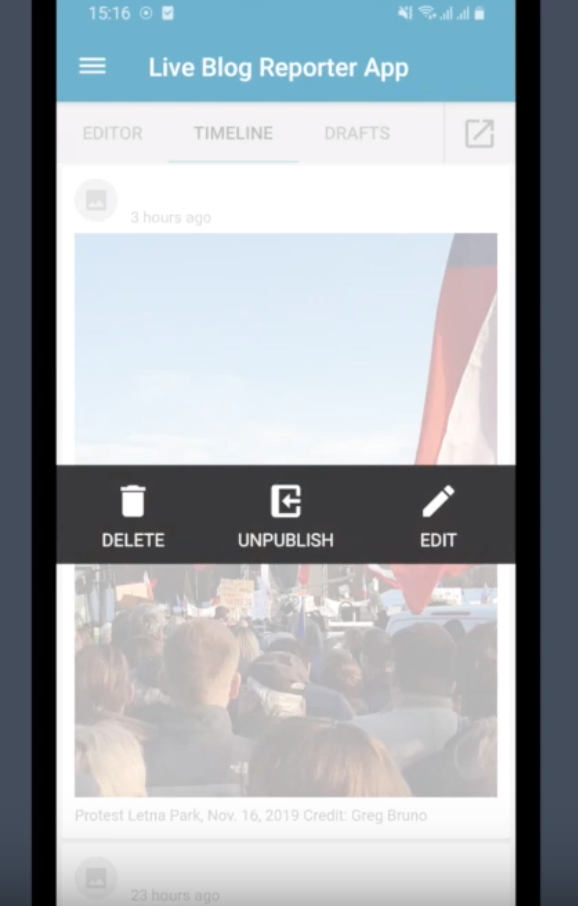by Greg Bruno | September 20, 2024
Notice: Trying to get property 'name' of non-object in /var/www/liveblogpro/wp-content/themes/launchkit/archive.php on line 4
January 23, 2020
Guide to Live Blogging: Everything you need to know

Guide to Live Blogging: Everything you need to know
In today’s news cycle, there’s no time for down time: live blogs are one of the best ways to deliver information quickly. But what, exactly, is live blogging, and what are live blogs good for, and which live blogging tool should you use? Good questions; here are some answers.
What is a live blog, anyway?
A live blog, sometimes referred to as “live text,” is a blog post that provides a rolling textual coverage of an ongoing event supplemented with images, videos, and other digital material. According to The Guardian: “Live blogs provide commentary and analysis alongside breaking news rather than summarising the event after it is over. It’s a transparent format in which the writers are able to update and amend their commentaries in easily digestible paragraphs.”
Live blogging can be used for a wide variety of events and circumstances – such as sporting events, elections, concerts, award ceremonies and conferences. Although live blogs are constantly evolving, news organisations use live blogs for a number of reasons: to reach wider audiences, to increase the transparency of the traditional news-making process, to increase content engagement, and even to generate new streams of revenue through blog syndication.
Live blogging through the ages
What started in the mid-2000s as a software tool for techies to broadcast technology conferences has since become an essential story format for journalists and other information providers to distribute digital coverage in chronological order.
Personalisation is a live blog’s comparative advantage. Unlike television, which must be watched in a linear way and in real time (although viewers can record it and watch it later), live blogs allow readers to start at any point in the story and reread, save, share, and digest information at their own pace.
Why live blogging?
Live blogs are widely read. In 2012, research by City University London found that live blogs get 300% more views and 233% more visitors than conventional online articles on the same subject. Live blogs also outperform online picture galleries, getting 219% more visitors. In 2013, the Reuters Institute for the Study of Journalism found that readers increasingly prefer live blogs to static content and believe live coverage to be more balanced and neutral. Additionally, 62% of survey takers said live blogs are the best format to consume news at work.
More recent data shows that audiences are spending less time reading full news stories and more time engaging with highlights and breaking news – everything from Steph Curry’s three-point buzzer beater to coverage of natural disasters. In fact, when big news breaks, studies show that readers actively seek out quality information through online search – before content is shared on social media. That’s one reason why having a live blog dedicated to breaking news coverage will boost your site’s profile online.
But the benefits are not limited to the immediate time during and after an event. It turns out that readers go back, again and again, to visit live blog timelines of events in the past. “Our experience is that live blogs drive lots of traffic to our site,” said Sybille Klormann, an editor at Zeit Online covering politics and economics. “We are often surprised at how many people visit these blogs, especially during elections, but also show a continued interest afterwards.”
Bottom line: “Live blogging can be a very valuable resource to your readers if done right,” says professional blogger Cameron Chapman. “If you take the time and keep focused throughout an event to provide useful information to your readers, they’ll often consider your blog the go-to place for event coverage in your industry. If it’s done poorly, though, all those blog posts will likely just be looked at as filler or fluff by your readers, and may even annoy some to the point they unsubscribe from your RSS feed.”
Proven use cases for live liveblogging
Live blogs can be used for covering a wide-array of news stories and banner events – as breaking news, elections, esports, conferences, award shows, and live sports. But even the most niche topics can find an audience with a well-done live blog.
Aleks Vickovich, wealth and legal managing editor at Momentum Media in Australia, says one company publication, ifa (Independent Financial Adviser) used a live blog to cover two weeks of financial hearings in 2018. As a result, ifa saw its new traffic increase by 200%. For a publication with “an extremely niche audience of hard core fans,” Vickovich said the growth made possible with live blog was staggering. “We had something like 60,000 unique visits in the two-week period, which is about twice what we usually get in a month.”
Part of that success is because live blog content is becoming more visible in web searches. Why does this matter? Because when the text of a live blog post appears as native content to search engines, it raises the profile of that news organisation’s coverage in new web searches, and also helps with the site’s overall SEO (search engine optimisation). Live blogs provide fresh, relevant content and increase engagement – essentially, longer session durations – through real-time updates, both of which are important factors in enhancing a website’s search rankings. Additionally, integrating LiveBlogPosting schema can improve a live blog’s visibility by indicating that an article is connected to a live event, helping it stand out in search results.
How to live blog successfully
The Internet is full of tips on how to live blog properly, and it can be a challenge to cut through the digital noise. To help you make the most out of your live blogging activity, we’ve collated some of the best insights from across the industry:
Step #1 | Choose the right live blog software
First you need to pick a live blogging platform that serves your needs. Sourcefabric’s Live Blog is a powerful, professional open-source live blogging tool created for journalists and bloggers on the go. It includes rich media posts – like image slideshows and video streams – as well as custom post types and scorecards for covering sporting events.
Additionally, Live Blog offers easy ways to monetise your coverage with tools to integrate native or remote ads into your live blog’s timeline.
The platform also offers a mobile reporting app (Live Blog Reporter) that allows your live blog team to contribute directly from their mobile phones. The app is particularly useful for events such as protests, concerts, and music festivals, where reporters need to write their live blog on the go, unencumbered by bulky equipment.
Step #2 | Plan your coverage BEFORE you start blogging
Once you’ve got your live blogging software picked out, now you need to think deeply about your topic and your blogging strategy. Start by identifying topics that your audience cares about. Whether it’s an important political debate, a major sports match, or a significant cultural event, choose live blogging topics that align with your readers’ passions and interests. After selecting your topic, develop a strategic approach. Coming up with material ad hoc is not the best practice for maintaining a successful live blog. Even though events unfolding in real time often leave little to no opportunity to prepare, there will inevitably be in-between moments where not much is happening. During these times, it’s important for you to have relevant material prepared in advance, general knowledge on the topic you’re covering, and reliable contacts who can assist you.
Step #3 | Think in terms of editorial resources
Producing a good live blog requires people. Some practical questions to consider: is there enough staff available at that particular moment and are there reporters on the scene able to provide information, verify facts, as well as submit images and videos? If the answer is no, perhaps a live blog isn’t the correct format.
Step #4 | Build in communication and collaboration tools
Using established lines of communication is essential for a time-sensitive format like live blogging. If you have a team of more than one, how will you share information about the blog’s content? Whether it’s a tool like Slack or email, you’ll need a way to exchange ideas and content before it’s posted.
Step #5 | Experiment
Because news consumers have taken a much greater interest in live blogs, the go-to form of storytelling offers endless opportunities for innovating. New organisations use live blogging for boosting audience engagement, increasing transparency in the news-production process, and even to generate revenue. There’s really no end to how a live blog can be deployed.
Live Blog examples
Below you will find a variety of live blog examples from around the web that best illustrate the potential of the format.
Der Tagesspiegel has been using Live Blog to provide continuous real-time updates on the Russia-Ukraine war. Their live coverage keeps audiences informed on breaking news with minute-by-minute developments throughout the conflict, such as military operations, reactions from global readers, and interactive maps.

Tagesspiegel implemented Live Blog for real-time insights on the Russia-Ukraine war
Danmarks Idrætsforbund (the National Olympic Committee and Sports Confederation of Denmark) used Live Blog for the Paralympics to deliver real-time reporting of the event. They included a variety of social media content to make their coverage more visual and interactive for readers.

Danmarks Idrætsforbund used Live Blog for their Paralympics’ coverage
The Eurovision Song Contest used the Live Blog platform in the past to manage their live updates, incorporating social media and different forms of multimedia into Eurovision’s overall branding and corporate identity. The live blogging software efficiently handled tens of thousands of concurrent users, allowing the organisers to share highlights of the events and behind-the-scenes content without any technical issues.

The Eurovision Song Contest’s live blog complemented their branding nicely
The M100 Sanssouci Colloquium is an international media conference held every year in Potsdam, bringing together representatives from traditional, independent, democratic media, alongside voices from politics and science, to discuss current socio-political developments and the media’s role in international affairs. They used Live Blog to provide real-time coverage of the conference, improving discussion and engagement by allowing digital participation and highlighting speaker quotes. The live blogging platform created an accessible, interactive experience for both online and on-site attendees.

M100 Sanssouci Colloquium used Live Blog for their conference
Frequently asked questions about live blogging
How do I decide what to live blog about?
Select topics that happen in real-time and are of high interest, such as major sports or music events or breaking news. Watch out for trending topics and choose something relevant to your audience.
What makes a good live blog?
A good live blog provides timely updates, accurate and relevant information, and engaging content that keeps readers coming back. Consistent updates and interactive elements, such as polls or a comment section, can improve the overall experience.
How profitable are live blogs?
Live blogs can be profitable depending on different factors such as traffic volume and a good monetisation strategy. Revenue can come from native or remote ads, sponsorships, and premium content.
What are the best topics for live blogging?
Popular topics for live blogging include sports, such as the NBA or the Champions League, major news events, and notable entertainment events like the Oscars or the Eurovision Song Contest. Choose a niche with a broad fanbase and audience. Timeliness and relevance are key.
For Live Blog tutorials, check out our YouTube channel or our blog.
Editor’s note: This post was originally published in 2020 and has been updated in 2024 to include new, relevant insights and information.
January 20, 2020
Mobile Blogging with the Live Blog Reporter App

Mobile Blogging with the Live Blog Reporter App
by Greg Bruno | Jan 20, 2020
In the modern media landscape, audiences expect news when it happens. Live blogs are one of the fastest ways to deliver it, and with our mobile blogging tool, updating readers has never been easier.
In this post (and in the video below) we’re going to demonstrate how to set up and use the Live Blog Reporter App, which gives your blog writers the ability to write and file from anywhere.
We recently tested the app at a pro-democracy protest in Prague to show you how convenient mobile live blogging can be.
1st Step: Install the Reporter App
The first step is to install the Reporter App on the mobile device you want to work from. Search for “Live Blog Reporter” in the iOS or Google Play app stores. Once you’ve got the app on your device, make sure you’re registered as a user and team member for the Live Blog you want to work on. And, if you need a Live Blog instance, visit liveblog.pro to try Live Blog for free.
Once your account is up and running, the next step is to log into the app. On the app’s home screen enter the URL of your Live Blog instance, your username, and your password. Now, locate the blog you want to work on from your organisation’s Blog List. You can only work on blog’s that are bolded; if a name is greyed out it means you don’t have access.
For this tutorial we’ll walk you through how to post images and videos shot from your device to your Live Blog timeline. We’re using images and videos that we took at a huge protest in Prague’s Letna Park in November 2019.
Step 2: Upload an image along with text
When you log into your Live Blog, you’ll be directed to the Editor pane by default. To post an image along with our text, click the “Image” icon on the app’s menu bar. Then select an image from your device’s gallery. Add a description and author information. Finally, save your work by clicking the “check mark” in the upper right-hand corner of the Editor window.

Adding an image
Step 3: Add additional elements
If you want to add additional elements to the post – whether it’s text, images, or videos – click the “plus” sign below the image you just upload.

Adding additional elements
Once you’re happy with your post, you can either save it as a “Draft” – a helpful option if you are in an area with weak Internet connectivity – “Submit” it for editorial approval based on your organisation’s workflow, or “Publish” it directly to your Live Blog’s timeline. To see your post in its published form, click the “Timeline” tab at the top of the app. Or visit your blog on the Web.
You can also “Delete,” “Unpublish” or “Edit” a post simply by clicking on it from the “Timeline” view within the App.

Delete, unpublish or edit
And there you have it. Live blogging on the go is as easy as it’s ever been with the Live Blog Reporter App. For more Live Blog tutorials, check out our YouTube channel or visit us at liveblog.pro.
January 14, 2020
Case Study: How Ambiental Jalisco is Using Live Blog for Digital-First Publishing

CASE STUDY
How Ambiental Jalisco is Using Live Blog for Digital-First Publishing
by Anna Rohleder | Jan 15, 2020
“Journalism for the protection of the environment” is the motto of Ambiental Jalisco (“Jalisco’s Environment”), a startup newspaper in Mexico focused on getting citizens involved in ecological issues that are literally in their backyard. Ambiental Jalisco publishes original investigative reporting, and also organises related community activities such as plogging, ie., jogging while picking up trash.
Increasing the public’s awareness of the environment and climate change are goals in themselves. But there is also a larger strategy at work: Ambiental Jalisco is the prototype for up to ten additional local news sites around Mexico, which are planned to become a cross-regional environmental reporting network under the umbrella of a think tank called EnviroPress.
To turn this vision into a reality, however, Amiental Jalisco has had to navigate a number of platform and workflow difficulties, some of which Sourcefabric was able to help solve.
The Challenge
Ambiental Jalisco was launched with a truly digital-first publishing strategy. “We design our news websites to operate as content aggregators, which means that we want to publish local news and content in a unique communication channel, with almost no external links and with strong emphasis on social networks,” says founder Alejandro Payan. Short articles or “notes” are published in the outlet’s social channels, including Facebook, Twitter, Instagram, and YouTube, with a link back to the website. In that sense, the website is more of a secondary destination, as the audience reads content on social media first.
When Ambiental Jalisco first launched its website, it lacked automatic archiving functionality. Another initial challenge was an editorial workflow that required content to be added manually. This not only created extra work for the site’s IT manager, but also limited the speed of publishing and the ability to respond to news in real time.
The Solution
As part of Sourcefabric’s media development work, Ambiental Jalisco received a pro-bono Live Blog instance. Our live blogging platform was embedded as a responsive element in the website, providing the dynamic, visually-interactive look of an infinite-scroll format.
Ambiental Jalisco has made the most of Live Blog’s multimedia features and social media integration. Each of their posts features several photos and often a video, along with highlighted pull quotes.
Along with delivering a better experience for readers, Live Blog has also made the editorial workflow more efficient. Payan says:
“Live Blog has strengthened our publishing capabilities by allowing multi-user access to the editing and posting interface.”
In other words, now the website’s reporters can publish stories themselves as soon as they are written and approved, rather than waiting for the IT manager to manually update the website.

Ambiental Jalisco news feed
The Results
With enhanced speed of publishing and ease of use, Ambiental Jalisco has been able to increase its output of content and diversify the kinds of stories published. “With Live Blog we deliver information in real time, to improve knowledge that brings us closer to sustainability,” Payan says. “And what is especially important is that when readers visit the website, they will find information about only one topic: environmental protection in their cities.”
January 9, 2020
Monetise Your Live Blog With Ads and Affiliate Deals

TIPS AND TRICKS
Monetise Your Live Blog With Ads and Affiliate Deals
by Todd Jatras | Jan. 9, 2020
Today’s most successful news organisations rely on an ever-growing arsenal of digital tools to attract readers and keep them engaged. Live blogging has been around for a while, but is increasingly becoming a key component for news sites in the battle to retain and grow audiences. A blogging platform such as our Live Blog offers a dynamic, feature-rich format that is ideal for covering niche topics or using it to break news then update the story with real-time coverage as events unfold.
There are numerous ways that a well-designed blogging strategy can contribute to the overall health of a site’s news ecosystem, but today we will focus on boosting the bottom line by learning to monetise your blog via ads and affiliate deals.
As a cloud-based, open-source editorial tool that can be embedded in any website, Live Blog offers a host of features such as custom design themes, syndication tools, a mobile app and the ability to easily integrate rich multimedia formats and social media posts into an editorial timeline. Live Blog is highly flexible and scalable, and is used not only by some of the world’s leading news agencies, but also by smaller, independent publishers and even one-person operations. For stories that require frequent updating (elections, sports, conferences, and unexpected events such as natural catastrophes or political uprisings), you’d be hard-pressed to beat its live coverage capabilities. There are also great opportunities to make money from a live blog. You can demo Live Blog for free, and find detailed answers to any questions you may have in our helpdesk.
Complete Control Over Ads on Your Blog
Live Blog supports multiple types of advertising, giving you a great degree of control over what ads appear on your blog. Our advertising manager allows you to build your own native ads and place them within your blog as you see fit. Instead of being tied to third-party ad providers such as Google AdSense or Doubleclick, where you have little control over ads and their placement, these native ads are easy to archive, schedule and populate on a user’s various timelines. Of course, remote ads from those third-party providers can also be thrown into the mix by entering the ad’s code snippet. This gives you the best of both worlds when it comes to ads.
Live blogging also lends itself particularly well to specialised, niche topics, which opens many unique possibilities for native ad selling. To use one example, if one of your blogs is sports related, you could pitch the leagues you cover, sporting goods stores, apparel and equipment manufacturers or even radio and TV networks that broadcast relevant events. Advertisers crave highly targeted audiences and are willing to pay a premium to reach them. With Live Blog you are free to pursue an almost unlimited world of profit opportunity there. Of course, selling ads is a lot of work and requires constant relationship building and maintenance. But it’s a crucial option to have, and it’s also nice to have the option of third-party ads as a fall-back position as you get started.
Affiliate Marketing Pays Dividends
Affiliate marketing is another proven revenue generator, and is practically tailor-made for blogging. Whether your blog’s focus is electronics, fashion, music, books, or many other products, there is a great opportunity to embed affiliate links and promo codes in your product features and receive a commission when a reader clicks through and buys.
Amazon.com is without a doubt the biggest player, and their program lets you promote any of the more than 600 million items on their platform. Some companies have their own affiliate programs and can be approached individually, but the most common approach is to use an affiliate network. Awin and Webgains are two of the majors. They act as intermediaries, connecting companies and affiliates and can save you a lot of time finding the right brand partnerships.
One thing’s for certain, well-produced blogs that thoroughly cover niche topics attract dedicated readers who will keep returning in search of the latest news and reviews of the products they are passionate about. They are also the most likely to read a positive review and decide to purchase on the spot. So, be sure to set up and include affiliate links in your reviews to give your most loyal readers that option.
Combine the Two and Watch Your Revenues Grow
Done together, these two strategies should provide a significant boost for your blog’s bottom line. Of the two, it’s far easier to set up an affiliate program. It can basically be done in a day. And don’t forget, it should also be done retroactively, so all those stellar reviews you’ve already produced can be quickly linked to get the commissions rolling in. As far as advertising goes, this can be a fun-but-time-consuming pursuit, but a creative one that will definitely pay off with persistence and hard work.
